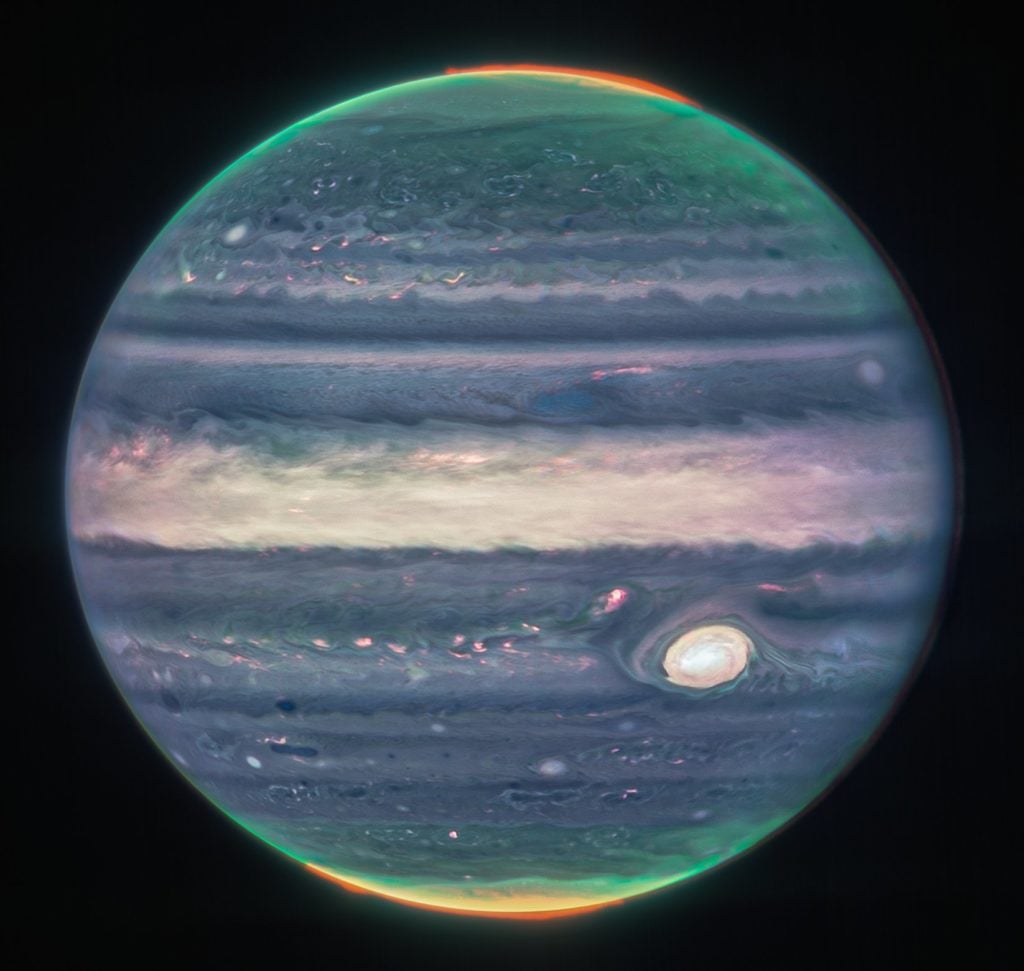
New photographs of Jupiter taken by the James Webb Space Telescope were made public by NASA. Webb’s views of Jupiter will provide researchers with considerably more information about the planet’s interior.
Imke de Pater, a professor emeritus of planetary astronomy at the University of California Berkeley, said that they “hadn’t really expected it to be this good, to be honest.’’
As part of a global partnership for Webb’s Early Release Science program, de Pater co-led the observations of Jupiter with Thierry Fouchet, a professor at the Paris Observatory. CSA and the European Space Agency are partners in the international effort known as Webb, which is headed by NASA.
De Pater said, “It’s really remarkable that we can see details on Jupiter together with its rings, and tiny satellites in one image.”
The observatory’s Near-Infrared Camera (NIRCam), which has three specialized infrared filters, produced two photos. Since infrared light cannot be seen by the human eye, it has been mapped onto the visible spectrum.
The shortest wavelengths are typically represented as more blue whereas the longest wavelengths typically appear redder. To convert the Webb data into photos, scientists worked with amateur scientist Judy Schmidt.
In the composite image of many Webb photographs used to produce the standalone view of Jupiter, auroras can be seen extending to great heights above both the northern and southern poles of the planet.
The light from the auroras is filtered via a redder color map, highlighting light reflected from lower clouds and upper hazes. The northern and southern poles can be seen to be surrounded by hazes in a separate filter that is mapped to yellows and greens. The light that is reflected from a deeper main cloud is displayed by a third filter that is blue-mapped.
Because they are reflecting a lot of sunlight, the Great Red Spot, a renowned storm so large it might engulf Earth, and other clouds appear white in these photos.
Webb transdisciplinary scientist for solar system observations and vice president for science at AURA, Heidi Hammel, stated that “the brightness here indicates high altitude so the Great Red Spot has high-altitude hazes, as does the equatorial region. The numerous bright white ‘spots’ and ‘streaks’ are likely very high-altitude cloud tops of condensed convective storms.”
Information from telescopes tedious to obtain
The information from telescopes such as Webb does not go to Earth in a tidy package. Instead, it includes details about how bright the light was on Webb’s sensor. The raw data for this information is sent to the Space Telescope Science Institute (STScI), which is Webb’s mission and science operations center. The Mikulski Archive for Space Telescopes receives the data after STScI transforms it into calibrated files for scientific examination.
During their research, scientists then convert the data into pictures. While a group at STScI formally prepares Webb photographs for publication, amateur astronomers known as citizen scientists frequently search through the public data library to retrieve and process images, as well.
Judy Schmidt, the amateur scientist processing images
These fresh pictures of Jupiter were analyzed by veteran amateur scientist Judy Schmidt of Modesto, California. She worked with Ricardo Hueso, a co-investigator on these observations who researches planetary atmospheres at the University of the Basque Country in Spain to create the image that shows the tiny satellites.
1. Make way for the king of the solar system! 👑
New Webb images of Jupiter highlight the planet's features, including its turbulent Great Red Spot (shown in white here), in amazing detail. These images were processed by citizen scientist Judy Schmidt: https://t.co/gwxZOitCE3 pic.twitter.com/saz0u61kJG
— NASA Webb Telescope (@NASAWebb) August 22, 2022
Schmidt has never received any formal training in astronomy. However, a ten-year-old ESA contest ignited her unquenchable passion for image processing. By entering the “Hubble’s Hidden Treasures” competition, anyone could discover brand-new treasures in the Hubble data. Schmidt won third place for a photograph of a newborn star out of around three thousand total entries.
She has been completing side projects involving Hubble and other telescope data since the ESA competition. “Something about it just stuck with me, and I can’t stop,” she said. “I could spend hours and hours every day.”
She processed pictures of nebulae, globular clusters, star nurseries, and other more stunning cosmic objects since she loved astronomy pictures. “I try to get everything to look natural…even if it’s not anything near to what your eye can see,” she says, summarizing her design philosophy. Professional astronomers are interested in these photographs, including Hammel who previously worked with Schmidt to improve Hubble images of comet Shoemaker-Levy 9’s collision on Jupiter.
Schmidt is delighted by new Webb images of star-forming regions, but Webb will provide observations about every stage of cosmic history. She is particularly intrigued by newborn stars called Herbig-Haro objects, which form strong jets in tiny nebula regions.
“I’m really looking forward to seeing these weird and wonderful baby stars blowing holes into nebulas,” she said.
See all the latest news from Greece and the world at Greekreporter.com. Contact our newsroom to report an update or send your story, photos and videos. Follow GR on Google News and subscribe here to our daily email!



